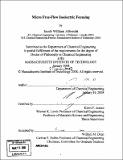Micro free-flow isoelectric focusing
Author(s)
Albrecht, Jacob William
DownloadFull printable version (33.59Mb)
Alternative title
Micro FF-IEF
Other Contributors
Massachusetts Institute of Technology. Dept. of Chemical Engineering.
Advisor
Klavs F. Jensen.
Terms of use
Metadata
Show full item recordAbstract
To unravel the complexity of cellular systems, protein prefractionation tools can be used to reduce cell lysate complexity and increase assay sensitivity. Rapid free flow isoelectric focusing (FF-IEF) is achieved in a microfluidic device by isolating the electrodes from the focusing region with porous buffer regions. Moving the electrodes enables the use of large electric fields without the detrimental effects of bubble formation in the focusing region of the device. The anode and cathode porous buffer regions, which are formed by acrylamide functionalized with immobilized pH groups, allow ion transport while providing buffering capacity. Thermo-electric cooling mitigates the effects of Joule heating on sample focusing at high field strengths (-500V/cm). This localized cooling was observed to increase device performance. Rapid focusing of low molecular weight isoelectric point markers proteins and protein complexes demonstrate the versatility of the technique. Simulations provide insight into and predict device performance based on a well-defined sample composition. This thesis also presents the first implementation of cascaded stages for a microfabricated free-flow isoelectric focusing device. Both analytical and computational models for IEF suggest device performance will be improved by utilizing multiple stages to reduce device residence time. These predictions are shown to be valid by using focusing of small IEF markers as a demonstration. We also show focusing of fluorescently tagged proteins under different channel geometries, with the most efficient focusing occurring in the cascaded design, as predicted by theory. An additional aim of this work is to demonstrate the compatibility of cascaded FF-IEF with common bioanalytical tools. As an example, outlet fractions from cascaded FF-IEF were analyzed by SDS-PAGE. Processing of whole cell lysate followed by immunoblotting for cell signaling markers demonstrates the reduction of albumin from samples, as well as the enrichment of apoptotic markers. Commercial FF-IEF equipment requires multiple inlets to approximate the linear pH gradient commonly used in IEF. These inlets require many premixed pH buffers and a dedicated pumping system, increasing system cost and complexity. (cont.) As an alternative approach, a preparative scale FF-IEF microfluidic device is also designed and tested. The advantages of the divergent IEF design versus a rectangular design are demonstrated using pH indicators to visualize the formation of pH gradients within the devices. Theoretical and experimental observations indicate that using a divergent channel circumvents many of the difficulties associated with preparative FF-IEF equipment. Protein pI markers are used to demonstrate the devices ability to fractionate samples, even in the presence of salt levels too high for conventional IEF techniques. The devices process complex biological samples, fractionating whole cell lysate at a rate of 2mL/hr. The device performance is further analyzed by 2-D gels of the fractionated outlets to show that cell lysate can be enriched based on pI. These findings underscore the promise of small, inexpensive, and disposable FF-IEF devices in proteomics and systems biology research.
Description
Thesis (Ph. D.)--Massachusetts Institute of Technology, Dept. of Chemical Engineering, 2008. Includes bibliographical references (p. 173-181).
Date issued
2008Department
Massachusetts Institute of Technology. Department of Chemical EngineeringPublisher
Massachusetts Institute of Technology
Keywords
Chemical Engineering.